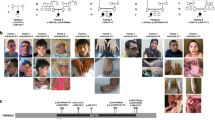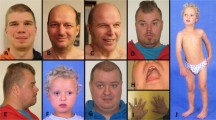Abstract
U2 small nuclear RNA auxiliary factor 2 (U2AF2) is an indispensable pre-mRNA splicing factor in the early process of splicing. Recently, U2AF2 was reported as a novel candidate gene associated with neurodevelopmental disorders. Herein, we report a patient with a novel presumed heterozygous missense variant in the U2AF2 gene (c.603G>T), who has a similar clinical phenotype as the patient reported before, including epilepsy, intellectual disability, language delay, microcephaly, and hypoplastic corpus callosum. We reviewed the phenotypic and genetic spectrum of patients with U2AF2-related neurological diseases, both newly diagnosed and previously reported. To investigate the possible pathogenesis, EBV-immortalized lymphoblastoid cells were derived from the peripheral blood obtained from the patient and control groups. Furthermore, according to the results of WB, RT-PCR, Q-PCR, and cDNA sequencing of RT-PCR products, the presumed missense variant c.603G>T caused exon 6 skipping in the U2AF2 mRNA transcript and led to a truncated protein (p.E163_E201del). Cell Counting Kit-8 (CCK-8) and cell cycle detection demonstrated that the variant c.603G>T inhibited the proliferation of patient lymphocyte cells compared with the control group. This study is aimed at expanding the phenotypic and genetic spectrum of U2AF2-related neurodevelopmental diseases and investigating the potential effects. This is the first report of the possible pathogenesis of a U2AF2 gene pathogenic variant in a patient with neurodevelopmental diseases and shows that a novel presumed missense variant in the U2AF2 gene causes exon skipping.
This is a preview of subscription content, access via your institution
Access options
Subscribe to this journal
Receive 12 print issues and online access
$259.00 per year
only $21.58 per issue
Buy this article
- Purchase on Springer Link
- Instant access to full article PDF
Prices may be subject to local taxes which are calculated during checkout




Similar content being viewed by others
Data availability
The authors confirm that the data supporting the findings of this study are available within the article.
References
Jin Y, Dong H, Shi Y, Bian L. Mutually exclusive alternative splicing of pre-mRNAs. Wiley Interdiscip Rev RNA. 2018;9:e1468.
Keren H, Lev-Maor G, Ast G. Alternative splicing and evolution: diversification, exon definition and function. Nat Rev Genet. 2010;11:345–55.
Lerner MR, Steitz JA. Antibodies to small nuclear RNAs complexed with proteins are produced by patients with systemic lupus erythematosus. Proc Natl Acad Sci USA 1979;76:5495–9.
Plaschka C, Newman AJ, Nagai K. Structural basis of nuclear pre-mRNA splicing: lessons from yeast. Cold Spring Harb Perspect Biol. 2019;11:a032391.
van der Feltz C, Hoskins AA. Structural and functional modularity of the U2 snRNP in pre-mRNA splicing. Crit Rev Biochem Mol Biol. 2019;54:443–65.
Gama-Carvalho M, Krauss RD, Chiang L, Valcarcel J, Green MR, Carmo-Fonseca M. Targeting of U2AF65 to sites of active splicing in the nucleus. J Cell Biol. 1997;137:975–87.
Glasser E, Maji D, Biancon G, Puthenpeedikakkal AMK, Cavender CE, Tebaldi T, et al. Pre-mRNA splicing factor U2AF2 recognizes distinct conformations of nucleotide variants at the center of the pre-mRNA splice site signal. Nucleic Acids Res. 2022;50:5299–312.
Cho S, Moon H, Loh TJ, Jang HN, Liu Y, Zhou J, et al. Splicing inhibition of U2AF65 leads to alternative exon skipping. Proc Natl Acad Sci USA 2015;112:9926–31.
Sciarrillo R, Wojtuszkiewicz A, Assaraf YG, Jansen G, Kaspers GJL, Giovannetti E, et al. The role of alternative splicing in cancer: From oncogenesis to drug resistance. Drug Resist Updat. 2020;53:100728.
Biamonti G, Amato A, Belloni E, Di Matteo A, Infantino L, Pradella D, et al. Alternative splicing in Alzheimer’s disease. Aging Clin Exp Res. 2021;33:747–58.
Padgett RA. New connections between splicing and human disease. Trends Genet. 2012;28:147–54.
Maji D, Glasser E, Henderson S, Galardi J, Pulvino MJ, Jenkins JL, et al. Representative cancer-associated U2AF2 mutations alter RNA interactions and splicing. J Biol Chem. 2020;295:17148–57.
Glasser E, Agrawal AA, Jenkins JL, Kielkopf CL. Cancer-associated mutations mapped on high-resolution structures of the U2AF2 RNA recognition motifs. Biochemistry. 2017;56:4757–61.
Kang HS, Sanchez-Rico C, Ebersberger S, Sutandy FXR, Busch A, Welte T, et al. An autoinhibitory intramolecular interaction proof-reads RNA recognition by the essential splicing factor U2AF2. Proc Natl Acad Sci USA 2020;117:7140–9.
Kaplanis J, Samocha KE, Wiel L, Zhang Z, Arvai KJ, Eberhardt RY, et al. Evidence for 28 genetic disorders discovered by combining healthcare and research data. Nature. 2020;586:757–62.
Hiraide T, Tanaka T, Masunaga Y, Ohkubo Y, Nakashima M, Fukuda T, et al. Global developmental delay, systemic dysmorphism and epilepsy in a patient with a de novo U2AF2 variant. J Hum Genet. 2021;66:1185–7.
Peng J, Pang N, Wang Y, Wang XL, Chen J, Xiong J, et al. Next-generation sequencing improves treatment efficacy and reduces hospitalization in children with drug-resistant epilepsy. CNS Neurosci Ther. 2019;25:14–20.
Richards CS, Bale S, Bellissimo DB, Das S, Grody WW, Hegde MR, et al. ACMG recommendations for standards for interpretation and reporting of sequence variations: revisions 2007. Genet Med. 2008;10:294–300.
Chatrikhi R, Feeney CF, Pulvino MJ, Alachouzos G, MacRae AJ, Falls Z, et al. A synthetic small molecule stalls pre-mRNA splicing by promoting an early-stage U2AF2-RNA complex. Cell Chem Biol. 2021;28:1145–57.e6.
Lin CL, Taggart AJ, Lim KH, Cygan KJ, Ferraris L, Creton R, et al. RNA structure replaces the need for U2AF2 in splicing. Genome Res. 2016;26:12–23.
Vuong CK, Black DL, Zheng S. The neurogenetics of alternative splicing. Nat Rev Neurosci. 2016;17:265–81.
Furlanis E, Scheiffele P. Regulation of neuronal differentiation, function, and plasticity by alternative splicing. Annu Rev Cell Dev Biol. 2018;34:451–69.
Weyn-Vanhentenryck SM, Feng H, Ustianenko D, Duffie R, Yan Q, Jacko M, et al. Precise temporal regulation of alternative splicing during neural development. Nat Commun. 2018;9:2189.
Jiang Y, Zhou J, Zhao J, Zhang H, Li L, Li H, et al. The U2AF2 /circRNA ARF1/miR-342-3p/ISL2 feedback loop regulates angiogenesis in glioma stem cells. J Exp Clin Cancer Res. 2020;39:182.
Laliotis GI, Chavdoula E, Paraskevopoulou MD, Kaba A, La Ferlita A, Singh S, et al. AKT3-mediated IWS1 phosphorylation promotes the proliferation of EGFR-mutant lung adenocarcinomas through cell cycle-regulated U2AF2 RNA splicing. Nat Commun. 2021;12:4624.
Li J, Cheng D, Zhu M, Yu H, Pan Z, Liu L, et al. OTUB2 stabilizes U2AF2 to promote the Warburg effect and tumorigenesis via the AKT/mTOR signaling pathway in non-small cell lung cancer. Theranostics. 2019;9:179–95.
Wang GS, Cooper TA. Splicing in disease: disruption of the splicing code and the decoding machinery. Nat Rev Genet. 2007;8:749–61.
Weisschuh N, Buena-Atienza E, Wissinger B. Splicing mutations in inherited retinal diseases. Prog Retin Eye Res. 2021;80:100874.
Nakai K, Sakamoto H. Construction of a novel database containing aberrant splicing mutations of mammalian genes. Gene. 1994;141:171–7.
Khan M, Cornelis SS, Sangermano R, Post IJM, Groesbeek AJ, Amsu J, et al. In or out? New insights on exon recognition through splice-site interdependency. Int J Mol Sci. 2020;21:2300.
Kralovicova J, Borovska I, Kubickova M, Lukavsky PJ, Vorechovsky I. Cancer-Associated Substitutions in RNA Recognition Motifs of PUF60 and U2AF65 reveal residues required for correct folding and 3’ splice-site selection. Cancers (Basel). 2020;12:1865.
Li Y, Chen S, Zhang X, Zhuo N. U2 small nuclear RNA auxiliary factor 2, transcriptionally activated by the transcription factor Dp-1/E2F transcription factor 1 complex, enhances the growth and aerobic glycolysis of leiomyosarcoma cells. Bioengineered. 2022;13:10200–12.
Sheikh O, Yokota T. Restoring protein expression in neuromuscular conditions: a review assessing the current state of exon skipping/inclusion and gene therapies for duchenne muscular dystrophy and spinal muscular atrophy. BioDrugs. 2021;35:389–99.
Maruyama R, Yokota T. Tips to design effective splice-switching antisense oligonucleotides for exon skipping and exon inclusion. Methods Mol Biol. 2018;1828:79–90.
Acknowledgements
We are grateful to the patient and his parents for their participation in this study. We thank Guizhi Tang (Hunan Key Laboratory of Medical Genetics, Central South University, China) for helping immortalize lymphocytes.
Funding
This work was supported by the National Natural Science Foundation of China (82071462, 81771409), the Natural Science Foundation of Hunan Province (2021JJ40969), and the Epilepsy Research Foundation of the China Association Against Epilepsy (CX-A-2021-17).
Author information
Authors and Affiliations
Contributions
Conceptualization: XW and JP; investigation: XW, HH, and XN; formal analysis: XW, BY, FL, and NP; resources: XW, CC, and ZP; writing—original draft preparation: XW; writing—review, and editing: JP. All authors commented on previous versions of the manuscript. All authors read and approved the final manuscript.
Corresponding author
Ethics declarations
Competing interests
The authors declare no conflict of interest.
Ethics
This study was reviewed and approved by the Ethics Committee of Xiangya Hospital of Central South University.
Consent to participate
Written informed consent was obtained from the patients.
Consent for publication
The authors affirm that human research participants provided informed consent for the publication of the images or data included in this article.
Additional information
Publisher’s note Springer Nature remains neutral with regard to jurisdictional claims in published maps and institutional affiliations.
Supplementary information
10038_2023_1128_MOESM2_ESM.docx
Supplementary Information 2. The evolutionary conservation of the E201D mutation in the U2AF2 gene among humans and various vertebrates
Rights and permissions
Springer Nature or its licensor (e.g. a society or other partner) holds exclusive rights to this article under a publishing agreement with the author(s) or other rightsholder(s); author self-archiving of the accepted manuscript version of this article is solely governed by the terms of such publishing agreement and applicable law.
About this article
Cite this article
Wang, X., You, B., Yin, F. et al. A presumed missense variant in the U2AF2 gene causes exon skipping in neurodevelopmental diseases. J Hum Genet 68, 375–382 (2023). https://doi.org/10.1038/s10038-023-01128-2
Received:
Revised:
Accepted:
Published:
Issue Date:
DOI: https://doi.org/10.1038/s10038-023-01128-2
This article is cited by
-
Identification of quantitative trait loci and candidate genes for seed folate content in soybean
Theoretical and Applied Genetics (2023)



